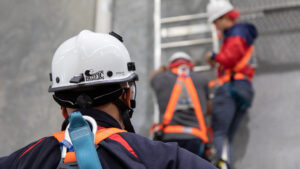Engineered stone – sometimes called manufactured stone – has become a popular material in recent decades. But with that popularity has come an increased awareness of the workplace dangers associated with the crystalline silica dust that is produced when the material is worked with.
The use of engineered stone (manufactured stone) has been exploding in popularity through the 1980s and into the 2000s. It offered builders and homeowners the ability to have stone-type features, without the expense of using natural stone.
Unfortunately, engineered stone produces significant amounts of crystalline silica dust when it is cut or ground. Being exposed to this dust puts workers at risk of contracting severe respiratory diseases and lung cancers.
What is crystalline silica?
Crystalline silica is a form of silicon dioxide (which itself is commonly known as silica). Silicon dioxide is one of the most abundant substances on Earth. It is a constituent component of sand, soil, rocks, glass, and many other common substances found in nature.
The most common form of crystalline silica a worker is likely to come across is the mineral quartz. Samples of quartz can have a silica content greater than 90%.
Crystalline silica can also be found in gravel, bricks, mortar, sandstone and many, many other building products, and materials.
What is engineered stone?
Engineered stone is a man-made material where different types of stone and rock are crushed into a fine powder, then bound together using either a resin or cement-based adhesive in a mould to form specific shapes and slabs.
Generally, engineered stone is very similar to natural stone, but lacks the variation, cracks, flaws, and discolouration that can occur in nature. Engineered stones can also be harder and more flexible than natural stones, this makes them a more appealing option in residential and commercial applications.
Uses of engineered stone
Engineered stone is used in just about as many cases as natural stones would be – from decorative elements of a house design to bench tops, tiles, splashbacks, and indoor flooring.
Over recent decades engineered stone has become the material of choice for those building new homes or renovating. This came about due it being cheaper to install than natural stone, and the ability to manufacture slabs closer to the required final dimensions.
They also tend to have a much more uniform shape and consistency, which reduces the likelihood of coming across an issue during installation.
Engineered stones can also be made to look very similar to their natural counterparts, but without many of the drawbacks. Natural stones can have imperfections and impurities present in a slab, while these are avoided using a manufactured stone product.
Engineered stones are also virtually non-porous, meaning that water and other liquids will not be absorbed into the stone. This makes them more durable and less prone to staining than natural stone (especially when used in kitchens).
When is engineered stone dangerous?
The dangers from engineered stone arise when the material is cut or worked on in a way that produces fine dust particles.
Like asbestos fibres, the dust particles become embedded in the walls of the lungs and, over time, can increase the chances of developing silicosis and other types of lung cancers.
Once installed, there are no health risks associated with having engineered stone bench tops, counter tops, flooring, or other materials. Health issues are only present when the stone is being worked on – either through cutting, grinding, drilling or any other process that can result in dust particles being created.
Risk mitigation for engineered stone dust
Developing adequate risk mitigating when working with engineered stone can be done by applying the hierarchy of controls.
The best way to mitigate the risks associated with dust from engineered stone is to eliminate them by not working on engineered stone in the first place. However, as in many situations of workplace risk, this may not be possible.
Often, the best risk controls involve using specific procedures and equipment when working with engineered stone, along with appropriate personal protective equipment (PPE).
Work procedures can include moving to wet cutting stone, instead of dry cutting. This can significantly reduce the likelihood of dust particles becoming airborne.
If wet cutting is not possible, there are a range of dust capture extraction equipment available that and can limit the spread of silica dust produced. Some can be placed directly on the tool being used, while others work in different ways and in conjunction with sufficiently isolating the area where work is taking place.
The types of PPE that can be used when working with engineered and manufactured stone are like those used when working with asbestos containing materials.
Primarily, a mask is used to form a barrier between a potentially dust-filled atmosphere and the worker’s mouth.
Masks work though being made of material that allows air molecules to pass through, while blocking the larger dust particles from entering the mouth.
Which controls that need to be implemented depends on the work being undertaken and the environment being worked in.
Silica awareness training
There is training available to workers that provides instruction in identifying areas of concern when it comes to crystalline silica in the workplace. The nationally accreted 10830NAT Course in crystalline silica exposure prevention is the prescribed silica awareness training course in the Australian Capital Territory. The ACT Government has mandated that this unit of competency must be held by a range of trades and construction workers before they commence work in Canberra and the ACT.
Discuss your training needs with the team at Height Safety Engineers (RTO 91227) by calling 1300 884 978 or emailing enquiries@heightsafety.net.





